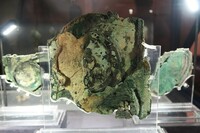C. 100 BC Ancient Greeks build the Antikythera mechanism
|
0001 The Antikythera mechanism is an ancient mechanical computer designed to calculate astronomical positions. It was recovered in 1901 from the wreck of a ship near the island of Antikythera, in the Mediterranean Sea. The mechanism is the oldest known complex scientific calculator. It contains many gears, and is sometimes called the first known analog computer, although its flawless manufacturing suggests that it may have had several undiscovered predecessors during the Hellenistic Period. The device appears to be constructed based on theories of astronomy and mathematics developed by Greek astronomers. It is estimated that it was made between 150 and 100 BC. The hand-cranked mechanism performed several operations, including:
The significance and complexity of the device were not understood until decades after its discovery. Technological artifacts of similar complexity and workmanship did not reappear until the 14th century, when mechanical astronomical clocks were built in Europe. The device is displayed at the National Archaeological Museum of Athens, accompanied by a reconstruction made and donated to the museum by Derek de Solla Price. The Antikythera mechanism features as the titular "Dial of Destiny" in the fifth Indiana Jones film. Related information: Image:
|
Click on the Images For Detail
|










